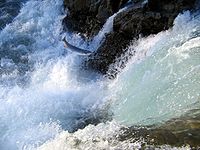
Photo from wikipedia
An 8-week feeding trial was conducted to investigate the effects of feeding rates on growth, feed utilization, and body composition of juvenile Pseudobagrus ussuriensis. Juvenile P. ussuriensis (initial body weight… Click to show full abstract
An 8-week feeding trial was conducted to investigate the effects of feeding rates on growth, feed utilization, and body composition of juvenile Pseudobagrus ussuriensis. Juvenile P. ussuriensis (initial body weight of 2.30 ± 0.01 g) were distributed into 15 tanks, and each tank was stocked with 30 fish. Satiation feeding (3.57% BW day−1) was determined by the point of cessation of voluntary feeding activity by fish. Five treatments that included triplicate groups were prepared for this study: 100% (satiation), 75, 50, and 25% of satiation groups and unfed group. The results indicated that weight gain (WG) and specific growth rate (SGR) increased with increasing feeding rates. WG and SGR of fish fed to satiation were significantly higher than that of fish fed to 50 and 25% of satiation and unfed fish (P < 0.05), but not significantly different from that of fish fed to 75% of satiation (P > 0.05). Feed efficiency (FE) and protein efficiency ratio (PER) of fish fed to 75% of satiation were significantly higher than that of fish fed other groups. There was a trend towards increased whole-body crude lipid and decreased whole-body moisture with increasing feeding rates, while whole-body protein content was not significantly affected by feeding rates. Condition factor and hepatosomatic index were increased with increasing feeding rates (P < 0.05), while there was no significant difference in viscerosomatic index with increasing feeding rates. Considering these experimental results, it can be concluded that the optimum feeding rate for growth of juvenile P. ussuriensis could be lowered to 75% of satiation without growth suppression.
Journal Title: Aquaculture International
Year Published: 2017
Link to full text (if available)
Share on Social Media: Sign Up to like & get
recommendations!